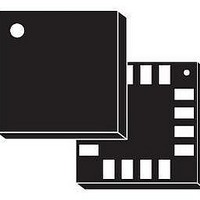LIS331HHTR STMicroelectronics, LIS331HHTR Datasheet - Page 20

LIS331HHTR
Manufacturer Part Number
LIS331HHTR
Description
ACCELEROMETER SENSOR 3AXIS 16-LG
Manufacturer
STMicroelectronics
Series
MEMS, nanor
Datasheet
1.STEVAL-MKI092V1.pdf
(37 pages)
Specifications of LIS331HHTR
Axis
X, Y, Z
Acceleration Range
±6g, 12g, 24g
Sensitivity
12mg/digit, 6mg/digit, 3mg/digit
Voltage - Supply
2.16 V ~ 3.6 V
Output Type
Digital
Bandwidth
50Hz ~ 1kHz Selectable
Interface
I²C, SPI
Mounting Type
Surface Mount
Package / Case
16-LGA
Package Type
LGA
Operating Supply Voltage (min)
2.16V
Operating Supply Voltage (typ)
2.5/3.3V
Operating Supply Voltage (max)
3.6V
Operating Temperature (min)
-40C
Operating Temperature (max)
85C
Operating Temperature Classification
Industrial
Product Depth (mm)
3mm
Product Height (mm)
1mm
Product Length (mm)
3mm
Mounting
Surface Mount
Pin Count
16
Sensing Axis
X, Y, Z
Acceleration
6 g, 12 g, 24 g
Digital Output - Number Of Bits
16 bit
Supply Voltage (max)
3.6 V
Supply Voltage (min)
2.16 V
Supply Current
10 uA
Maximum Operating Temperature
+ 85 C
Minimum Operating Temperature
- 40 C
Digital Output - Bus Interface
I2C, SPI
Shutdown
Yes
Lead Free Status / RoHS Status
Lead free / RoHS Compliant
Available stocks
Company
Part Number
Manufacturer
Quantity
Price
Company:
Part Number:
LIS331HHTR
Manufacturer:
APT
Quantity:
430
Part Number:
LIS331HHTR
Manufacturer:
ST
Quantity:
20 000
Digital interfaces
5.2.1
20/37
Figure 6.
CS is the serial port enable and it is controlled by the SPI master. It goes low at the start of
the transmission and goes back high at the end. SPC is the serial port clock and it is
controlled by the SPI master. It is stopped high when CS is high (no transmission). SDI and
SDO are respectively the serial port data input and output. Those lines are driven at the
falling edge of SPC and should be captured at the rising edge of SPC.
Both the read register and write register commands are completed in 16 clock pulses or in
multiple of 8 in case of multiple bytes read/write. Bit duration is the time between two falling
edges of SPC. The first bit (bit 0) starts at the first falling edge of SPC after the falling edge
of CS while the last bit (bit 15, bit 23, ...) starts at the last falling edge of SPC just before the
rising edge of CS.
bit 0: RW bit. When 0, the data DI(7:0) is written into the device. When 1, the data DO(7:0)
from the device is read. In latter case, the chip will drive SDO at the start of bit 8.
bit 1: MS bit. When 0, the address will remain unchanged in multiple read/write commands.
When 1, the address is auto incremented in multiple read/write commands.
bit 2-7: address AD(5:0). This is the address field of the indexed register.
bit 8-15: data DI(7:0) (write mode). This is the data that is written into the device (MSb first).
bit 8-15: data DO(7:0) (read mode). This is the data that is read from the device (MSb first).
In multiple read/write commands further blocks of 8 clock periods will be added. When MS
bit is ‘0’ the address used to read/write data remains the same for every block. When MS bit
is ‘1’ the address used to read/write data is increased at every block.
The function and the behavior of SDI and SDO remain unchanged.
SPI read
Figure 7.
SDO
SPC
SDI
CS
SDO
SPC
Read and write protocol
SPI read protocol
SDI
CS
RW
MS
RW
AD5 AD4 AD3 AD2 AD1 AD0
MS
AD5 AD4 AD3 AD2 AD1 AD0
Doc ID 16366 Rev 1
DO7 DO6 DO5 DO4 DO3 DO2 DO1 DO0
DI7 DI6 DI5 DI4 DI3 DI2 DI1 DI0
DO7 DO6 DO5 DO4 DO3 DO2 DO1 DO0
LIS331HH













